Slope Stability Analysis and Soil Mechanical Properties of Impact Craters around the Lunar South Pole
Abstract
1. Introduction
2. Materials and Methods
2.1. Data
2.2. Finite Element Strength Reduction Method
2.3. Two-Dimensional Model of Slope Stability of Lunar Impact Crater
3. Stability Analysis on Soil Slope of Lunar Impact Crater
3.1. Stability Analysis of Unloaded Soil Slopes
3.1.1. Slope Stability Affected by Different Slope Angles
3.1.2. Slope Stability Affected by Different Slope Heights
3.1.3. Slope Stability Affected by Different Soil Cohesion and Internal Friction Angles
3.2. Stability Analysis of Loaded Soil Slopes
3.2.1. Slope Stability Analysis Using Different Loading Pressures
3.2.2. Slope Stability Analysis Using Different Loading Positions
4. Soil Mechanical Properties Estimation of a Soil Slope Adjacent to the Traverse Path of the Chang’E-4 Yutu-2 Rover
5. Stability Analysis of Loaded Slopes in Potential Landing Regions of the Lunar South Pole
6. Conclusions
- (1)
- With the increase in slope angle and slope height, the slope tends to be unstable. With the increase in cohesion and the internal friction angle of lunar soil, the slope becomes more stable. The analysis results of the soil slope model under load conditions show that the soil slope tends to be unstable with the increase in load pressure. When the rover is in different positions, the further the rover is from the top of the slope, the more stable the slope.
- (2)
- The model result based on the true soil slope adjacent to the traverse path shows that the rover can pass by the slope safely, which is consistent with the facts. This provides a basis for the application of the FEM on the Moon. The calculated cohesion and internal friction angles, as two lower limits, are far lower than the Apollo 15 soil values. As a highly degraded impact crater, the impact crater has a small slope angle and height, which may lead to the stability of the slope.
- (3)
- Two-dimensional loaded models based on the Shoemaker and Shackleton craters were established and FoS lookup tables were created. Based on the FoS lookup tables for the Shoemaker and Shackleton crater slopes, the ultimate shear strength of the soil under different load pressures can be found. These will help to better assess the safety of future missions to explore the Moon. In addition, a higher level of cohesion of the lunar soil at the landing site is more conducive to maintaining the stability of the slope.
Author Contributions
Funding
Data Availability Statement
Acknowledgments
Conflicts of Interest
References
- Nozette, S.; Lichtenberg, C.L.; Spudis, P.; Bonner, R.; Ort, W.; Malaret, E.; Robinson, M.; Shoemaker, E.M. The Clementine bistatic radar experiment. Science 1996, 274, 1495–1498. [Google Scholar] [CrossRef]
- Feldman, W.C.; Maurice, S.; Binder, A.B.; Barraclough, B.L.; Elphic, R.C.; Lawrence, D.J. Fluxes of fast and epithermal neutrons from lunar prospector: Evidence for water ice at the lunar poles. Science 1998, 281, 1496–1500. [Google Scholar] [CrossRef] [PubMed]
- Ivanov, M.A.; Abdrakhimov, A.M.; Basilevsky, A.T.; Demidov, N.E.; Guseva, E.N.; Head, J.W.; Hiesinger, H.; Kohanov, A.A.; Krasilnikov, S.S. Geological characterization of the three high-priority landing sites for the Luna-Glob mission. Planet. Space Sci. 2018, 162, 190–206. [Google Scholar] [CrossRef]
- Mazarico, E.; Neumann, G.A.; Smith, D.E.; Zuber, M.T.; Torrence, M.H. Illumination conditions of the lunar polar regions using LOLA topography. Icarus 2011, 211, 1066–1081. [Google Scholar] [CrossRef]
- Zhang, L.; Li, J.; Zeng, Z.; Xu, Y.; Liu, C.; Chen, S. Stratigraphy of the Von Kármán Crater Based on Chang’E-4 Lunar Penetrating Radar Data. Geophys. Res. Lett. Geophys. Res. Lett. 2020, 47, e2020GL088680. [Google Scholar] [CrossRef]
- Kokelaar, B.P.; Bahia, R.S.; Joy, K.H.; Viroulet, S.; Gray, J.M.N.T. Granular avalanches on the Moon: Mass-wasting conditions, processes, and features. J. Geophys. Res. Planets 2017, 122, 1893–1925. [Google Scholar] [CrossRef]
- Senthil Kumar, P.; Keerthi, V.; Senthil Kumar, A.; Mustard, J.; Gopala Krishna, B.; Amitabh; Ostrach, L.R.; Kring, D.A.; Kiran Kumar, A.S.; Goswami, J.N. Gullies and landslides on the Moon: Evidence for dry-granular flows. J. Geophys. Res. Planets 2013, 118, 206–223. [Google Scholar] [CrossRef]
- Xiao, Z.; Zeng, Z.; Ding, N.; Molaro, J. Mass wasting features on the Moon—How active is the lunar surface? Earth Planet. Sci. Lett. 2013, 376, 1–11. [Google Scholar] [CrossRef]
- Robinson, M.S.; Brylow, S.M.; Tschimmel, M.; Humm, D.; Lawrence, S.J.; Thomas, P.C.; Denevi, B.W.; Bowman-Cisneros, E.; Zerr, J.; Ravine, M.A.; et al. Lunar Reconnaissance Orbiter Camera (LROC) Instrument Overview. Space Sci. Rev. 2010, 150, 81–124. [Google Scholar] [CrossRef]
- Di, K.; Zhu, M.H.; Yue, Z.; Lin, Y.; Wan, W.; Liu, Z.; Gou, S.; Liu, B.; Peng, M.; Wang, Y.; et al. Topographic Evolution of Von Kármán Crater Revealed by the Lunar Rover Yutu-2. Geophys. Res. Lett. 2019, 46, 12764–12770. [Google Scholar] [CrossRef]
- Scott, C.R. An Introduction to Soil Mechanics and Foundations, 3rd ed.; Chapman & Hall: Boca Raton, FL, USA, 1994. [Google Scholar]
- Bishop, A.W. The use of the Slip Circle in the Stability Analysis of Slopes. Geotechnique 1955, 5, 7–17. [Google Scholar] [CrossRef]
- Zienkiewicz, O.C.; Humpheson, C.; Lewis, R.W. Associated and non-associated visco-plasticity and plasticity in soil mechanics. Geotechnique 1975, 25, 671–689. [Google Scholar] [CrossRef]
- Potts, D.M.; Zdravkovic, L. Finite Element Analysis in Geotechnical Engineering Application; Thomas Telford: London, UK, 2001. [Google Scholar]
- Dawson, E.M.; Roth, W.H.; Drescher, A. Slope stability analysis by strength reduction. Geotechnique 1999, 49, 835–840. [Google Scholar] [CrossRef]
- Tschuchnigg, F.; Schweiger, H.F.; Sloan, S.W. Slope stability analysis by means of finite element limit analysis and finite element strength reduction techniques. Part II: Back analyses of a case history. Comput. Geotech. 2015, 70, 178–189. [Google Scholar] [CrossRef]
- Jiang, T.; He, T.; Liu, C.; Li, L. Soil deformation under cyclic horizontal load in sand: Insights from experiments. J. Eng. Res. 2023, in press. [Google Scholar] [CrossRef]
- Xia, C.; Shi, Z.; Li, B.; Liu, M. A discontinuous smooth particle hydrodynamics method for modeling deformation and failure processes of fractured rocks. J. Rock Mech. Geotech. Eng. 2023, in press. [Google Scholar] [CrossRef]
- Harnett, C.E.; Watson, R.A.; Holohan, E.P.; Schöpfer, M.P.J. Collapse caldera walls: Mechanical controls on slope failure and morphology. J. Volcanol. Geotherm. Res. 2023, 442, 107893. [Google Scholar] [CrossRef]
- Yang, Z.; Cheng, X. High fill slope collapse: Stability evaluation based on finite element limit analyses. Transp. Geotech. 2024, 44, 101156. [Google Scholar] [CrossRef]
- Xu, C.; Liu, Q.; Tang, X.; Sun, L.; Deng, P.; Liu, H. Dynamic stability analysis of jointed rock slopes using the combined finite-discrete element method (FDEM). Comput. Geotech. 2023, 160, 105556. [Google Scholar] [CrossRef]
- Huang, P.-C. An innovative partition method for predicting shallow landslides by combining the slope stability analysis with a dynamic neural network model. Catena 2022, 217, 106480. [Google Scholar] [CrossRef]
- Bart, G.D.; Nickerson, R.D.; Lawder, M.T.; Melosh, H.J. Global survey of lunar regolith depths from LROC images. Icarus 2011, 215, 485–490. [Google Scholar] [CrossRef]
- Li, C.; Su, Y.; Pettinelli, E.; Xing, S.; Ding, C.; Liu, J.; Ren, X.; Lauro, S.E.; Soldovieri, F.; Zeng, X.; et al. The Moon’s farside shallow subsurface structure unveiled by Chang’E-4 Lunar Penetrating Radar. Sci. Adv. 2020, 6, eaay6898. [Google Scholar] [CrossRef] [PubMed]
- Heiken, G.H.V.; David, T.; French, B.M. Lunar Sourcebook, a User’s Guide to the Moon; Cambridge University Press: Cambridge, UK, 1991. [Google Scholar]
- Qiao, L.; Ling, Z.; Fu, X.; Li, B. Geological characterization of the Chang’e-4 landing area on the lunar farside. Icarus 2019, 333, 37–51. [Google Scholar] [CrossRef]
- Qian, Y.; Xiao, L.; Yin, S.; Zhang, M.; Zhao, S.; Pang, Y.; Wang, J.; Wang, G.; Head, J.W. The regolith properties of the Chang’e-5 landing region and the ground drilling experiments using lunar regolith simulants. Icarus 2020, 337, 113508. [Google Scholar] [CrossRef]
- Wu, B.; Li, F.; Hu, H.; Zhao, Y.; Wang, Y.; Xiao, P.; Li, Y.; Liu, W.C.; Chen, L.; Ge, X.; et al. Topographic and Geomorphological Mapping and Analysis of the Chang’E-4 Landing Site on the Far Side of the Moon. Photogramm. Eng. Remote Sens. 2020, 86, 247–258. [Google Scholar] [CrossRef]
- Xiao, Z.; Ding, C.; Xie, M.; Cai, Y.; Cui, J.; Zhang, K.; Wang, J. Ejecta from the Orientale Basin at the Chang’E-4 Landing Site. Geophys. Res. Lett. 2021, 48, e2020GL090935. [Google Scholar] [CrossRef]
- Zhang, J.; Zhou, B.; Lin, Y.; Zhu, M.-H.; Song, H.; Dong, Z.; Gao, Y.; Di, K.; Yang, W.; Lin, H.; et al. Lunar regolith and substructure at Chang’E-4 landing site in South Pole–Aitken basin. Nat. Astron. 2020, 5, 25–30. [Google Scholar] [CrossRef]
- Tang, Z.; Liu, J.; Wang, X.; Ren, X.; Chen, W.; Yan, W.; Zhang, X.; Tan, X.; Zeng, X.; Liu, D.; et al. Physical and Mechanical Characteristics of Lunar Soil at the Chang’E-4 Landing Site. Geophys. Res. Lett. 2020, 47, e2020GL090935. [Google Scholar] [CrossRef]
- Liu, J.; Ren, X.; Yan, W.; Li, C.; Zhang, H.; Jia, Y.; Zeng, X.; Chen, W.; Gao, X.; Liu, D.; et al. Descent trajectory reconstruction and landing site positioning of Chang’E-4 on the lunar farside. Nat. Commun. 2019, 10, 4229. [Google Scholar] [CrossRef]
- Guo, D.; Fa, W.; Zeng, X.; Du, J.; Liu, J. Geochemistry of the Von Kármán crater floor and thickness of the non-mare ejecta over the Chang’e-4 landing area. Icarus 2021, 359, 114327. [Google Scholar] [CrossRef]
- Hou, J.; Li, L.; Li, S. Analysis of Topography and Composition of the Von Kármán Impact Crater. IOP Conf. Ser. Earth Environ. Sci. 2021, 658, 012049. [Google Scholar] [CrossRef]
- Lai, J.; Xu, Y.; Zhang, X.; Xiao, L.; Yan, Q.; Meng, X.; Zhou, B.; Dong, Z.; Zhao, D. Comparison of Dielectric Properties and Structure of Lunar Regolith at Chang’e-3 and Chang’e-4 Landing Sites Revealed by Ground-Penetrating Radar. Geophys. Res. Lett. 2019, 46, 12783–12793. [Google Scholar] [CrossRef]
- Around the Moon with NASA’s First Launch of SLS with Orion. Available online: https://www.nasa.gov/missions/artemis/around-the-moon-with-nasas-first-launch-of-sls-with-orion/ (accessed on 17 July 2022).
- Zhang, H.; Du, Y.; Li, F.; Zhang, H.; Ma, J.; Sheng, L.; Wu, K. Proposals for lunar south polar region soft landing sites selection. J. Deep Space Explor. 2020, 7, 232–240. [Google Scholar] [CrossRef]
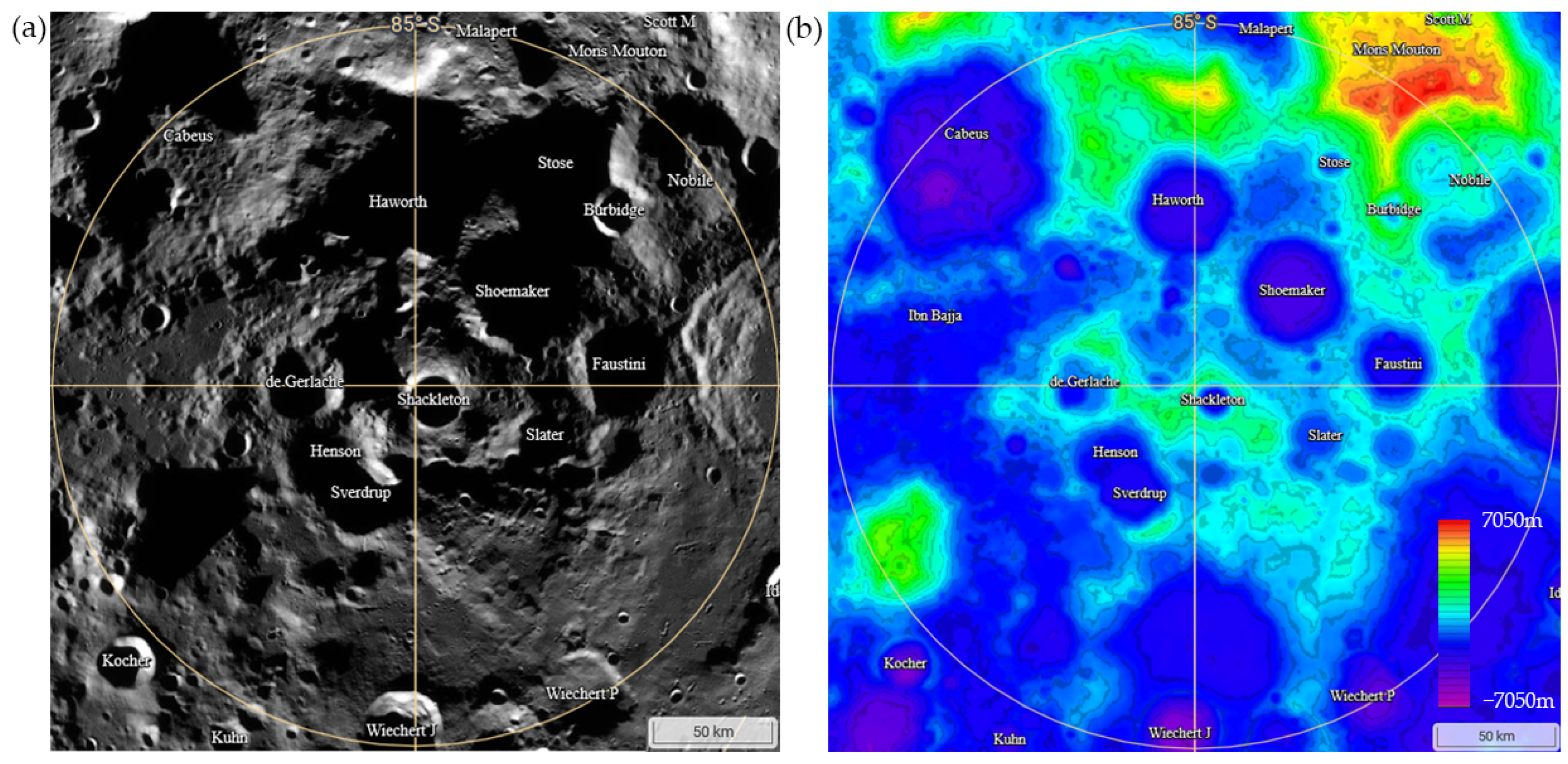
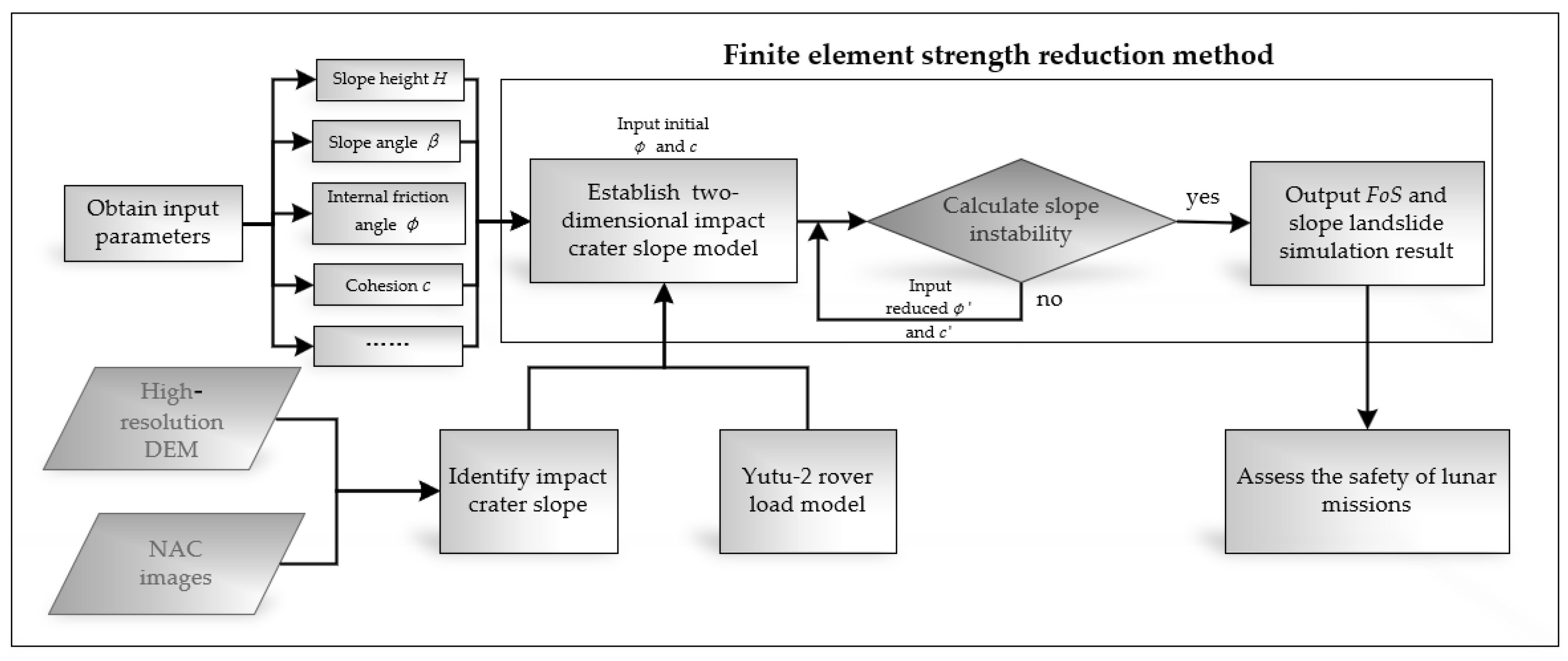
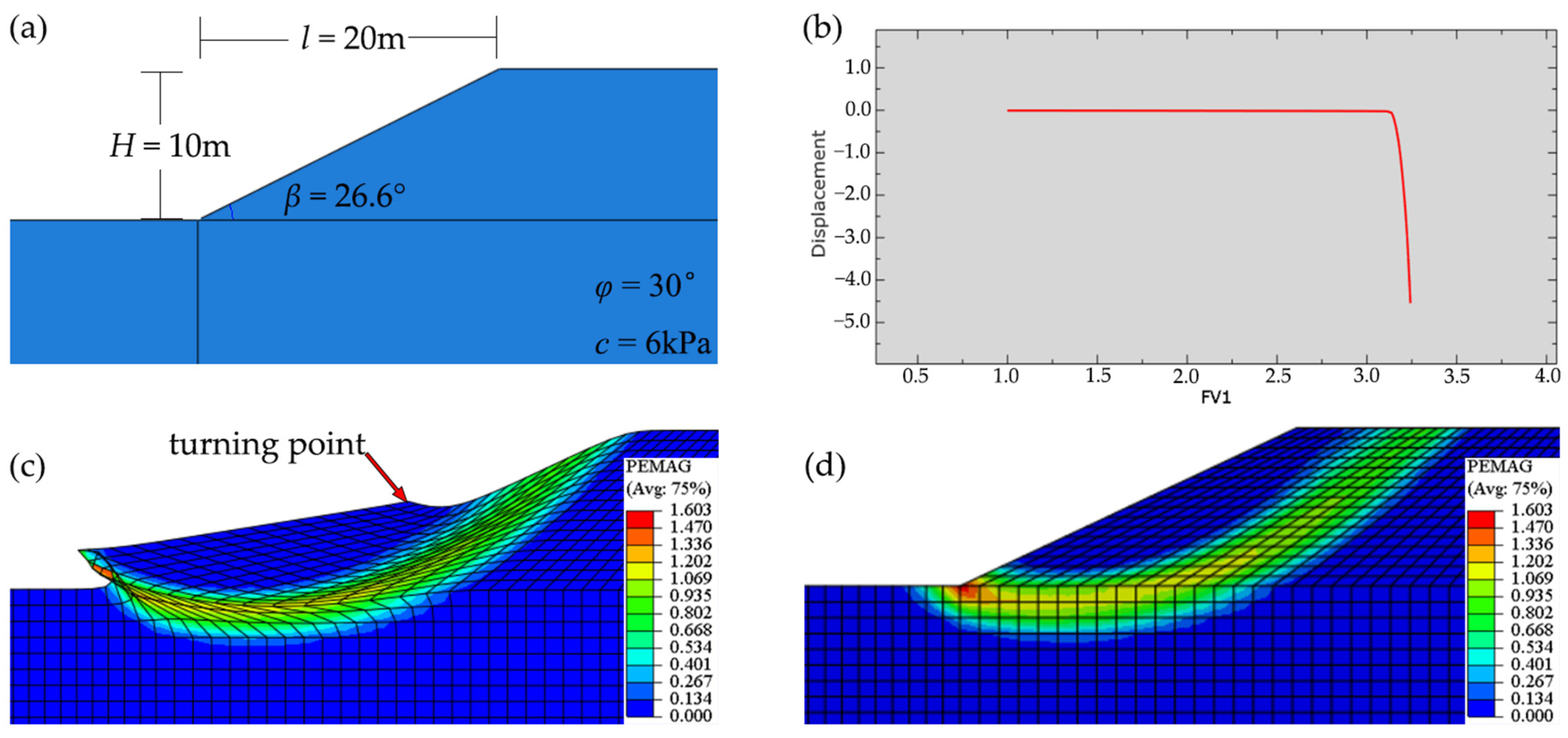
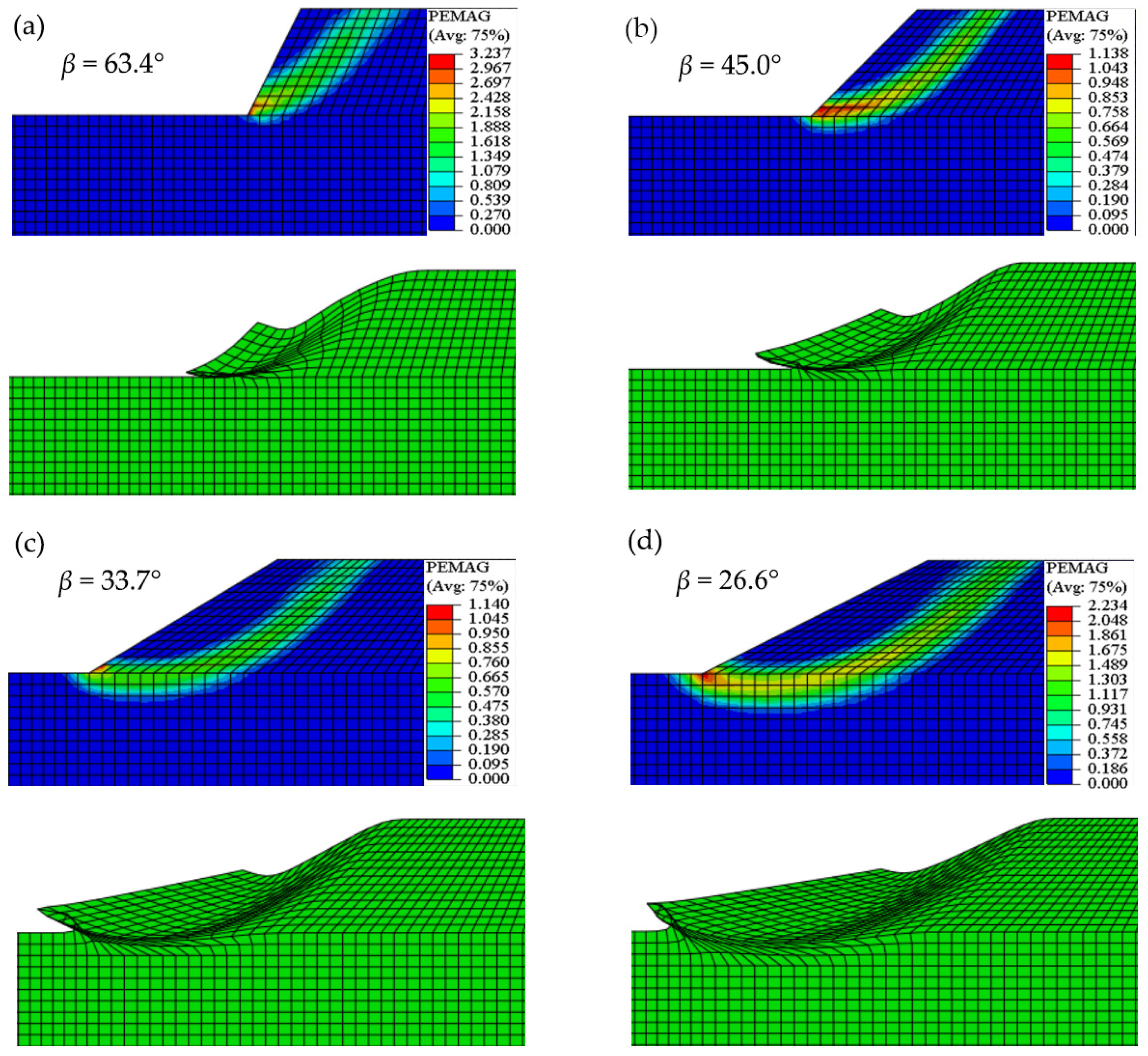
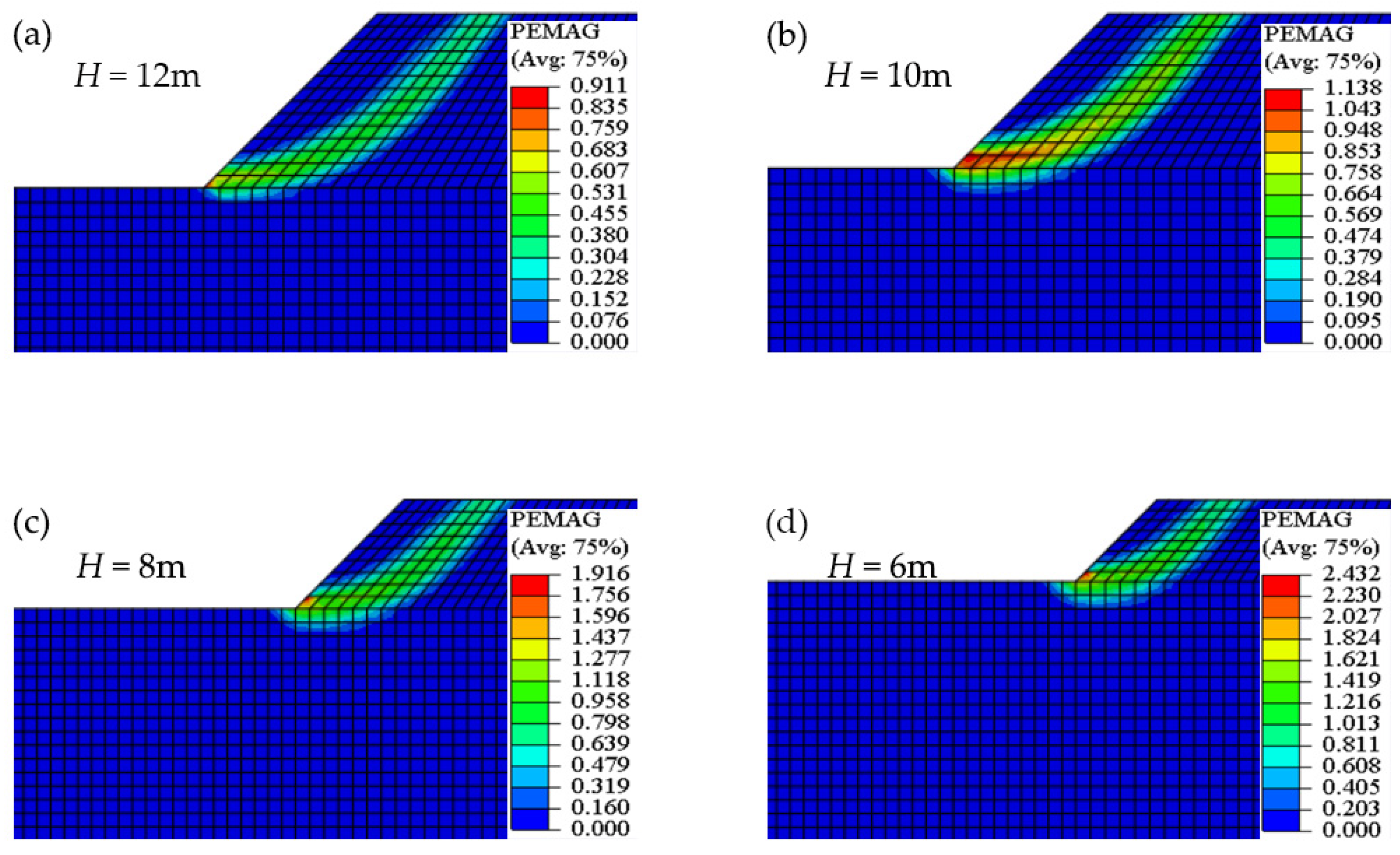

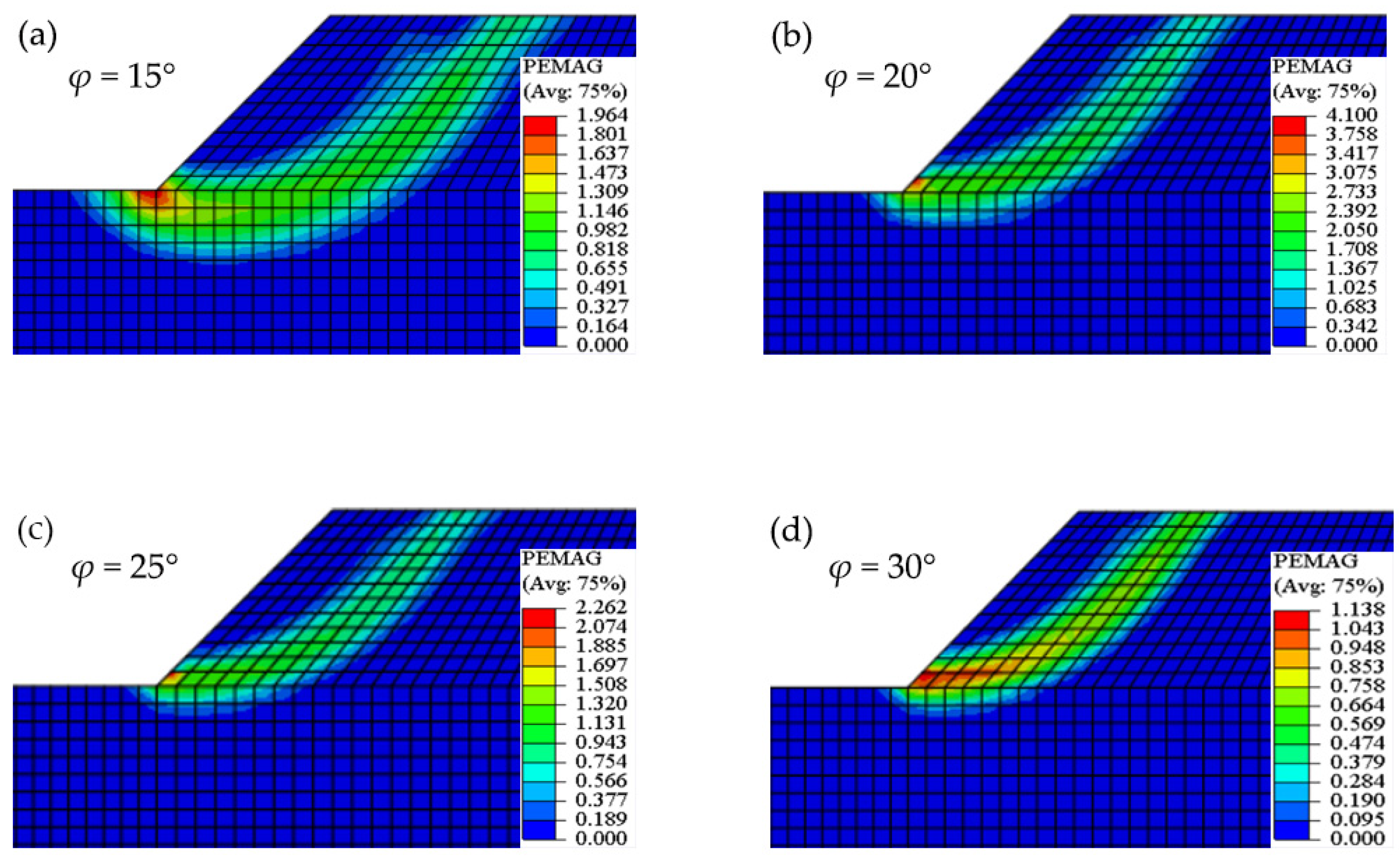

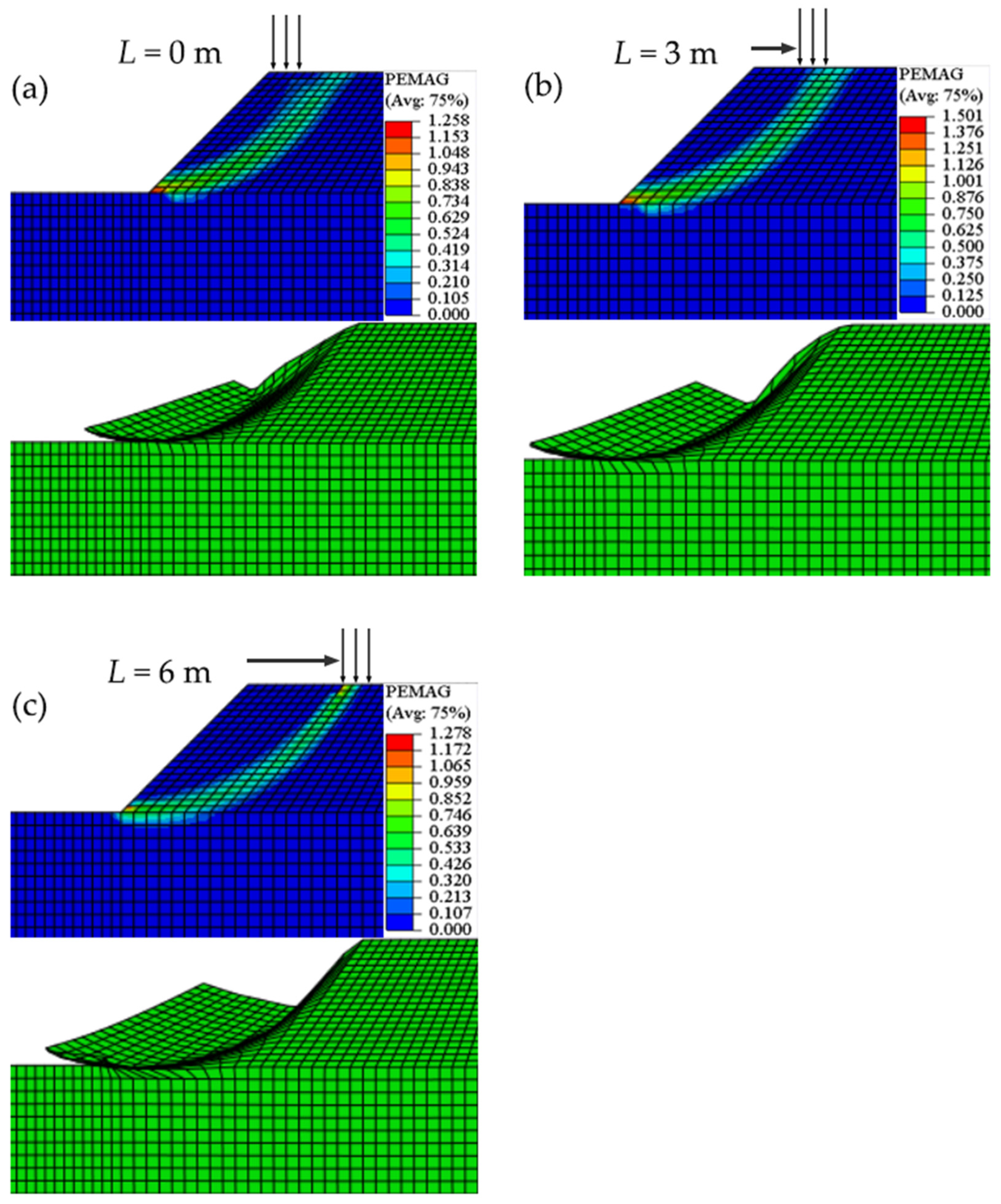
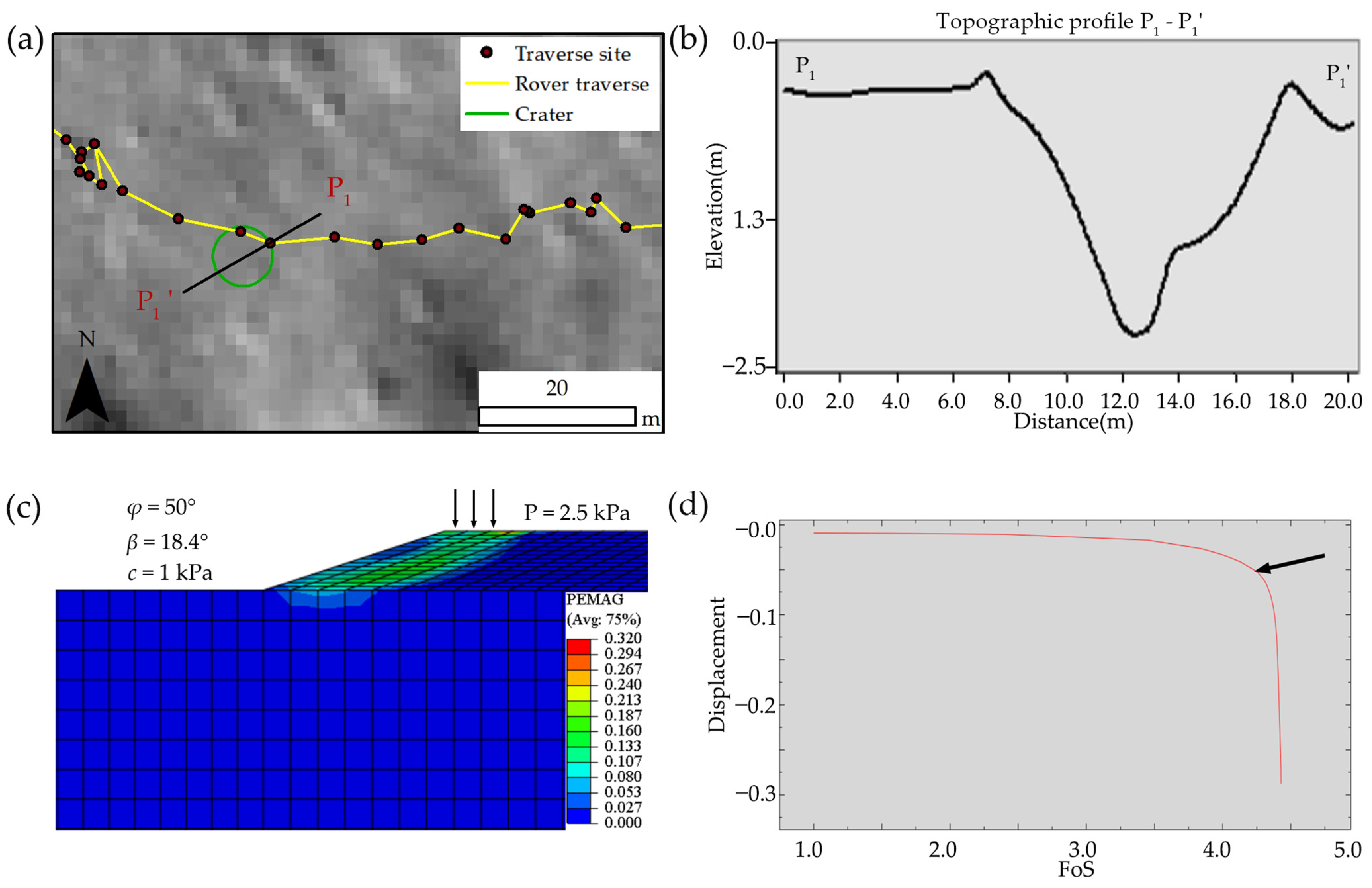
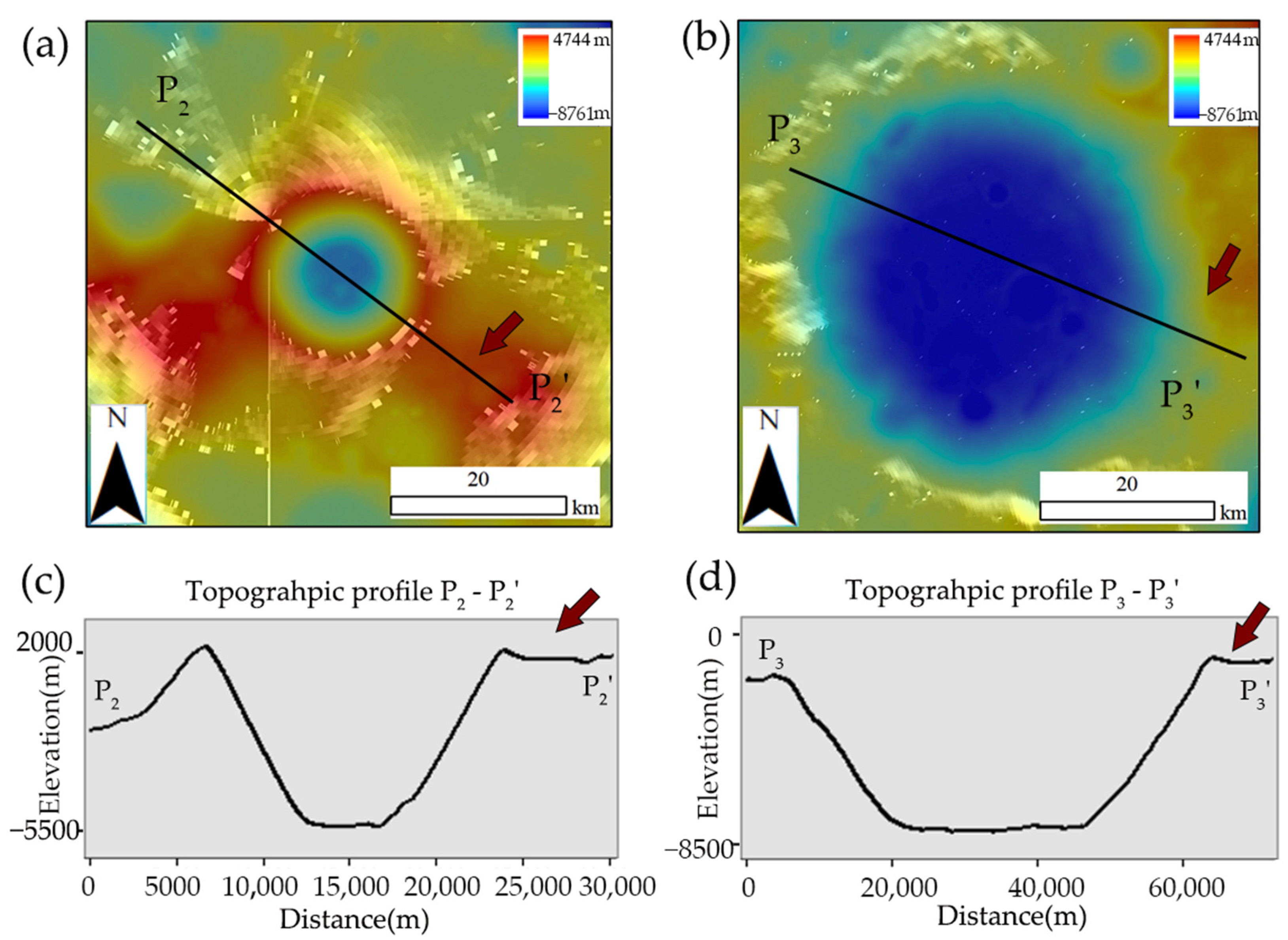
| Parameter (Unit) | Value | FoS |
|---|---|---|
| Slope angle (°) | 63.4 | 1.78 |
| 45.0 | 2.27 | |
| 33.7 | 2.85 | |
| 26.6 | 3.11 | |
| Slope height (m) | 12 | 2.02 |
| 10 | 2.27 | |
| 8 | 2.65 | |
| 6 | 3.14 | |
| Cohesion (kPa) | 6 | 2.27 |
| 9 | 2.93 | |
| 12 | 3.55 | |
| Internal friction angle (°) | 15 | 1.71 |
| 20 | 1.93 | |
| 25 | 2.10 | |
| 30 | 2.27 |
| Parameter (Unit) | Value | FoS |
|---|---|---|
| P (MPa) | 2.5 | 2.09 |
| 5 | 1.94 | |
| 10 | 1.83 | |
| 15 | 1.71 | |
| L (m) | 0 | 2.04 |
| 3 | 2.14 | |
| 5 | 2.54 |
| φ | c (kPa) | FoS | φ′ | c′ (kPa) |
|---|---|---|---|---|
| 30° | 0.5 | 2.000 | 16.110° | 0.250 |
| 0.8 | 2.465 | 13.189° | 0.325 | |
| 1 | 2.679 | 12.168° | 0.373 | |
| 40° | 0.8 | 3.093 | 15.186° | 0.259 |
| 1 | 3.342 | 14.101° | 0.299 | |
| 50° | 0.8 | 3.450 | 19.066° | 0.232 |
| 1 | 4.524 | 15.658° | 0.235 |
| P (kPa) | 1.5 | 3 | 4.5 | 6 | 7.5 | 9 |
|---|---|---|---|---|---|---|
| FoS | 2.245 | 2.226 | 2.202 | 2.162 | 2.158 | 2.14 |
| c′ (kPa) | 2.673 | 2.695 | 2.725 | 2.775 | 2.780 | 2.804 |
| φ′ | 14.430° | 14.548° | 14.699° | 14.959° | 14.986° | 15.106° |
| P (kPa) | 1.5 | 3 | 4.5 | 6 | 7.5 | 9 |
|---|---|---|---|---|---|---|
| FoS | 2.009 | 1.997 | 1.978 | 1.965 | 1.950 | 1.935 |
| c′ (kPa) | 0.996 | 1.002 | 1.011 | 1.018 | 1.026 | 1.034 |
| φ′ | 16.042° | 16.133° | 16.280° | 16.382° | 16.501° | 16.222° |
Disclaimer/Publisher’s Note: The statements, opinions and data contained in all publications are solely those of the individual author(s) and contributor(s) and not of MDPI and/or the editor(s). MDPI and/or the editor(s) disclaim responsibility for any injury to people or property resulting from any ideas, methods, instructions or products referred to in the content. |
© 2024 by the authors. Licensee MDPI, Basel, Switzerland. This article is an open access article distributed under the terms and conditions of the Creative Commons Attribution (CC BY) license (https://creativecommons.org/licenses/by/4.0/).
Share and Cite
Huang, Y.; Zhang, J.; Li, B.; Chen, S. Slope Stability Analysis and Soil Mechanical Properties of Impact Craters around the Lunar South Pole. Remote Sens. 2024, 16, 371. https://doi.org/10.3390/rs16020371
Huang Y, Zhang J, Li B, Chen S. Slope Stability Analysis and Soil Mechanical Properties of Impact Craters around the Lunar South Pole. Remote Sensing. 2024; 16(2):371. https://doi.org/10.3390/rs16020371
Chicago/Turabian StyleHuang, Yantong, Jiang Zhang, Bo Li, and Shengbo Chen. 2024. "Slope Stability Analysis and Soil Mechanical Properties of Impact Craters around the Lunar South Pole" Remote Sensing 16, no. 2: 371. https://doi.org/10.3390/rs16020371
APA StyleHuang, Y., Zhang, J., Li, B., & Chen, S. (2024). Slope Stability Analysis and Soil Mechanical Properties of Impact Craters around the Lunar South Pole. Remote Sensing, 16(2), 371. https://doi.org/10.3390/rs16020371





